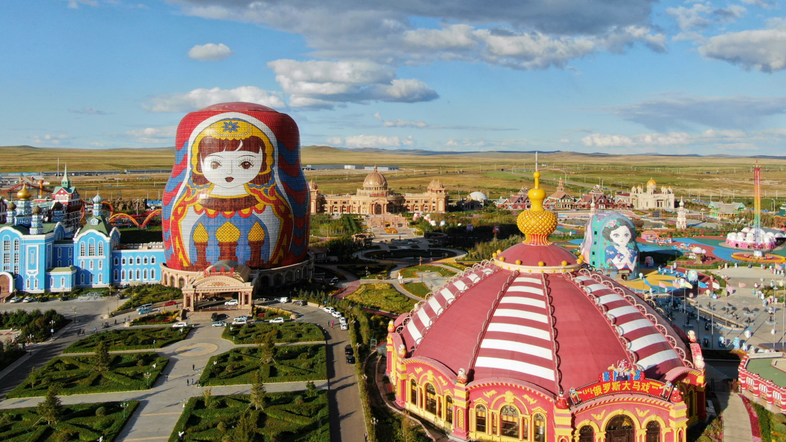
Chinese President Xi Jinping and Madame Peng Liyuan pose for a group photo with Mongolian President Ukhnaagiin Khurelsukh and First Lady Bolortsetseg in Beijing, capital of China, November 28, 2022. /Xinhua
Chinese President Xi Jinping and Madame Peng Liyuan pose for a group photo with Mongolian President Ukhnaagiin Khurelsukh and First Lady Bolortsetseg in Beijing, capital of China, November 28, 2022. /Xinhua
Editor's note: Hayat Bangash is a freelance columnist on international affairs with degrees in business administration and war studies.The article reflects the author's opinions and not necessarily the views of CGTN.
At the Great Hall of the People on November 28, Chinese President Xi Jinping welcomed Mongolian President Ukhnaagiin Khurelsukh for talks during the latter's state visit to China, which is his first visit to the country after taking office, and the second meeting between the two leaders since September this year.
China and Mongolia are continually upgrading their bilateral relations under a comprehensive strategic partnership that is enjoying increasing mutual trust and cooperation between them. The strategic nature of the relations is a reflection of the interests of the two countries' peoples. As neighbors and partners, this has long-term implications wherein the countries will pursue their bilateral, regional, and global goals through a common outlook.
There are three major lines of efforts upon which the two have reiterated to build their relations. First is the synergy between the China-launched Belt and Road Initiative (BRI) and Mongolia's Development Road Initiative to achieve a multiplying effect. As infrastructure projects, these initiatives are game changers in uplifting trade and touching the lives of people.
The second line of effort is between China's Global Development Initiative and Mongolia's New Recovery Policy. The two programs stand in line with each other when it comes to mitigating the effects of the economic stress caused by unfortunate events in recent years. The COVID-19 pandemic and food and energy crises around the world require a renewed focus on the economic well-being of people while promoting bilateral and multilateral collaboration.
The third synergetic effort that the two leaders agreed upon is between China's two-step development strategy and Mongolia's "Vision-2050" long-term development policy. Under the former, China is aiming to realize "socialist modernization" by 2035, and subsequently become "a great modern socialist country that is prosperous, strong, democratic, culturally advanced, harmonious and beautiful" by the middle of this century. Meanwhile, Mongolia will be achieving major milestones in the fields of human and economic development under its vision. When two strategies move along in alignment, they will have a complementary effect.
During the meeting, President Xi highlighted the close coordination that competent departments of the two countries will maintain to advance the China-Mongolia-Russia Economic Corridor (CMREC). This corridor is one of the major components of the BRI as it is pursuing a trilateral mechanism to achieve the goals of regional development.

A square decorated with oversized Russian Matryoshka dolls in Manzhouli, a China-Mongolia-Russia border port city, in north China's Inner Mongolia Autonomous Region, September 7, 2018. /Xinhua
A square decorated with oversized Russian Matryoshka dolls in Manzhouli, a China-Mongolia-Russia border port city, in north China's Inner Mongolia Autonomous Region, September 7, 2018. /Xinhua
CMREC's two key arteries, one extending from Beijing to Mongolia and Russia and the other extending from the northeastern Chinese city of Dalian to Russia, are focused on transport development to boost connectivity and encourage people-to-people exchanges through trade, culture, and investment.
A new rail line between China and Mongolia was inaugurated a day before President Khurelsukh's visit. The rail line comes at a time when air travel has been affected due to the COVID-19 pandemic.
The new rail line will increase the volume of trade between the two countries, which exceeded $10 billion last year. With a jump of 37 percent from the previous year, it is an achievement that trade after the pandemic is exponentially expanding. Mongolia's trade with China accounts for 63 percent of its total foreign trade and, with the maturity of CMREC, China-Mongolia trade will reach new heights.
In light of the prevailing global environment, President Xi emphasized how the values of multilateralism can be defended by the two countries' close coordination and collaboration. The two share common interests in the regional and global arena. A joint charting of strategies will enable them to navigate the modern challenges.
President Khurelsukh appreciated the commonalities between China and Mongolia's objectives. In continuation of the strategic relationship, his joint statement with President Xi highlighted the agreement on working together to achieve a community of shared future through mutual support.
President Khurelsukh also reiterated Mongolia's firm support of the one-China principle, stating that "it will never change." His support for the Global Development Initiative and Global Security Initiative was based on these initiatives' goals of achieving peace and development. He acknowledged that the efforts China is undertaking for global peace, stability, and development have the United Nations at their core. This is the reason the joint endeavors for greater peace and development in the region will strengthen in the coming years.
Consultations are ongoing at other levels between the two governments as well. In August, when their Foreign Ministers met in Ulaanbaatar, they resolved to strengthen exchanges and hold strategic consultations on policy affairs within the year.
China foresees a bigger role for Mongolia in international and regional affairs. The meeting between the two leaders serves as a testament that China is willing to share its experience with Mongolia in this regard. The two developing countries of Asia-Pacific have much to gain from aligning their development and foreign policies. As they move in that direction, their shared future will produce more win-win outcomes.
(If you want to contribute and have specific expertise, please contact us at opinions@cgtn.com. Follow @thouse_opinions on Twitter to discover the latest commentaries on CGTN Opinion Section.)